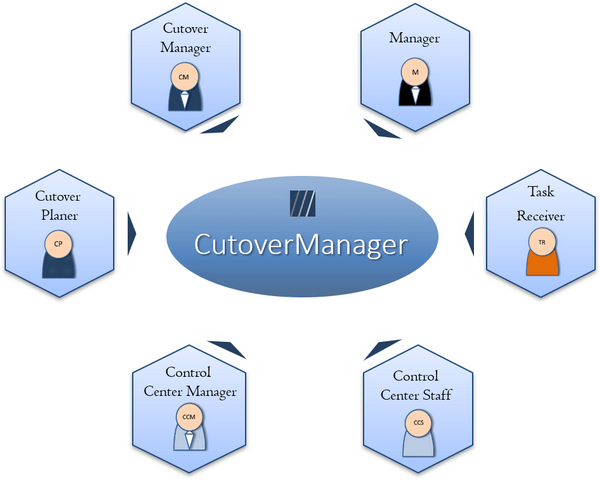Cutover Management
In the end, leave nothing to chance
Naturally, the focus of a project is on the actual cause of the project, i.e. the development of new software, the exchange of a software system, the introduction of new hardware, the development of new processes, the takeover/integration or the separation of companies or parts of companies from groups (mergers, carve-outs, etc.).
The task, time and resource planning of the project is focused on the WHAT, HOW and WHEN of the implementation of the project object.
In many projects a successive implementation and introduction of processes, software and hardware is possible and – for risk reasons – also desirable. In times of agile projects, where “time to market” is an important factor, this approach is a credo.
However, there are still projects that require a big bang go-live, i.e. a transition/go-live of many components in a limited time frame, such as a weekend. And here a successful cutover is the decisive, final step across the finishing line of the project.
Cutover definition
A cutover is the overall consideration (planning, execution and monitoring) of the migration from the old to the new system or from the old to the new process world. Core elements of the cutover are many small, interdependent and differentiated tasks that must be coordinated by a group of people (cutover team). Normally, the conversion of productive systems takes place at weekends, so the individual tasks are planned and executed in a tight schedule and in 24x7 mode.
Planning
With big bang projects it is advisable to deal with the go-live/cutover as early as possible and to assign experienced cutover specialists with the planning of the go-live event. Since a big bang scenario usually requires a few dress rehearsals prior to the actual go-live date, these must be integrated into the overall plan at an early stage. Experience has shown that the dress rehearsals take place with a corresponding time interval from each other and from the go-live date and therefore often start months before the cutover date. A sufficiently comprehensive and detailed cutover plan must already be available at this time.
For a cutover manager it is important to collect and document in detail the activities related to the go-live and their dependencies. But also control regular processes around the go-live date, such as end-of-day processing, guaranteed services and services such as customer portals, 24x7 system availability, etc. must be found out and considered in the cutover plan.
Some tasks in the cutover require a large time advance, e.g. the dispatch of customer information, changes to the general terms and conditions, etc., i.e. these points must be identified very early and their preparations/implementations commissioned accordingly early. If these points/tasks are already relevant for the dress rehearsals, they must be planned into a cutover plan months before the go-live date, initiated and their progress tracked.
In addition to the actual go-live-relevant tasks, resource planning for the dress rehearsals and the actual go-live event must also be prepared and coordinated at an early stage with the relevant employees, the HR department and, if necessary, also with official authorities (trade supervisory office, etc.) and appropriate approvals must be obtained. This requires hourly schedules of the individual employees based on the cutover plan.
As soon as the first comprehensive cutover plan has been drawn up, a phase plan must be created and regularly presented to the project stakeholders and top-level management.
The investigations, preparations, planning, coordination and above all the control of the dress rehearsals and the big bang are a great challenge for the cutover team and all parties involved. The question of a suitable tool or even the manual creation of a planning and control tool (possibly with Microsoft Excel) should not take up additional valuable time and resources.
Cutover software
In every project in which we have been responsible for the planning and implementation of the go-live, we have encountered the question of an appropriate cutover software, which is suitable for the planning but also for the control of the task execution. Usually Microsoft Excel was used, which in most cases cost us a lot of time for the initial creation and the necessary automation of the planning sheet.
Problems with stability, performance, the accidental destruction of links (when sorting, inserting or deleting lines), etc., or even complete crashes and the restoration of an older dataset, all cost us days of our valuable project time. In addition, during the initial planning phase we would often have liked to have the option of decentralized collection/recording of tasks, which is practically impossible with Microsoft Excel. Also, the presentation of the respective cutover progress from Excel was usually only possible with further, complex automations (macros, etc.).

For this reason, we took on the challenge to develop a reliable and easy-to-use software for the planning, coordination, control and reporting of the dress rehearsals and the actual cutover. With the CutoverManager we have succeeded in doing so. All regular and irregular processes and constellations in our previous cutovers could have been mastered without any problems with the functions available in CutoverManager. And we also received feedback from our customers that they were not able to master their challenges with the CutoverManager.
Success factors
In our experience, the following factors are important for a successful cutover planning and execution:
- Early collection and documentation of all tasks, their runtimes and dependencies in an overall plan
- Creation of a phase plan for coordination and communication with project participants, stakeholders and management
- Early communication with HR, works councils and, if applicable, official bodies
- Creation of transparency of the respective planning statuses for all project participants – at the latest when preparing the first dress rehearsal
- Early planning and coordination of the dress rehearsals
- Organization of a walk through with all participants for final coordination and validation of times and dependencies
- Performance of at least two test runs/general samples
- Relief for the cutover team through
- online availability of the respective status in the dress rehearsals/cutover in different levels of detail (tasks per employee, milestone plan for management)
- the highest possible degree of automation as well as extremely high stability and reliability of the cutover system used
- the stability and reliability of the cutover tool used
- Complete, audit-compliant historization of all changes for tracking and analyzing planning issues/errors
Changelog
October 10, 2020 – text revised and image added
April 3, 2020 – headlines revised
October 20, 2019 – publication
Recommended content
- Cutover – The supreme discipline of system launches
- Cutover: Successful planning and controlling with the CutoverManager
- The Loser at the End: Cutover software as success factor
